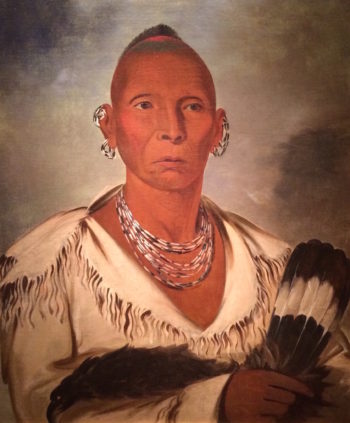Researcher Russ Fry claims they are buried in Burlington

George Catlin’s portrait of Black Hawk, an oil on canvas, as displayed at the National Portrait Gallery in Washington, D.C. Photo by Michael Swanger/Iowa History Journal
By Jerry Harrington
Russell Fry of Burlington has diligently dug through buried history, claiming to have unearthed his goal. But he refuses to reveal his final discovery — the burial site of legendary Chief Black Hawk.
Commonly accepted history says the war chief’s remains were destroyed in a fire in Burlington in 1853. Several years ago, however, Fry came across old newspaper accounts contradicting this assumption. He then began an historical detective expedition taking him through old documents, reaching another conclusion — that Black Hawk’s bones are buried in the Aspen Grove Cemetery in Burlington.
Fry will only say these remains are in the cemetery’s “potter’s field” section, reserved for unknown or indigent people. “I’ve contacted Black Hawk’s descendants in Oklahoma and they didn’t want the exact location known,” said Fry. “His bones have been removed before and they wanted him to rest in peace.”
For this reason, Fry remains silent about Black Hawk’s exact final resting place.
A Sauk and Fox war chief, Black Hawk played a pivotal role in the formation of frontier Iowa. Born near the present site of Rock Island, Ill., in 1767, Black Hawk grew into a fierce warrior, deeply resenting Americans’ westward movement. In 1832, he led a group of warriors, women and children to retake the place of his birth, the Sauk and Fox village of Saukenuk at modern-day Rock Island. This became known as the Black Hawk War.
The group was chased through Illinois and captured in present-day Wisconsin. Black Hawk surrendered, forever ending his challenge to Americans. Returning to the frontier in Iowa, Black Hawk died in 1838.
His legacy is that Black Hawk’s tribe was forced to cede to the Americans land in eastern Iowa called the Black Hawk Purchase. This opened up eastern Iowa to the Americans, flooding it with settlements and changing the land forever.
This is where Fry begins his story.
TO READ THE ENTIRE STORY AND OTHER FASCINATING STORIES ABOUT IOWA HISTORY, subscribe to Iowa History Journal. You can also purchase back issues at the store.
